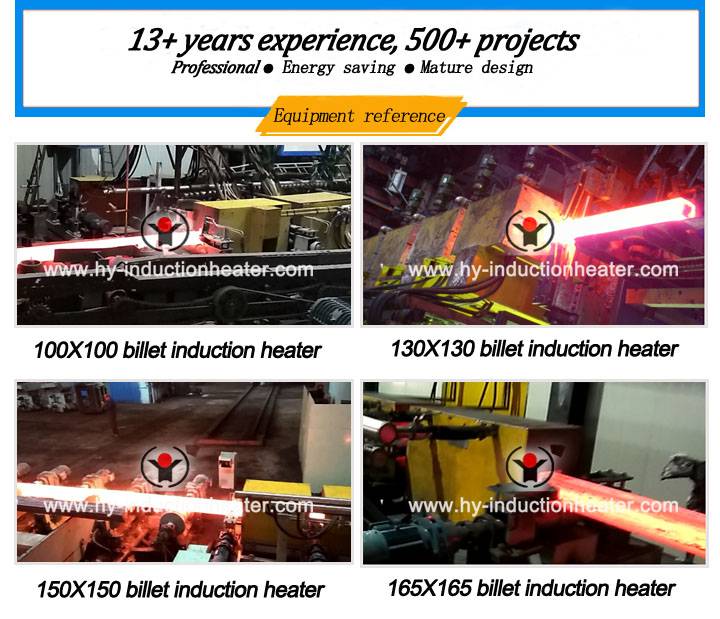Defects appearing during billet heating and their solutions
In the process of billet heating, the temperature and atmosphere of the furnace must be adjusted properly. If the operation is not proper, there will be various heating defects, such as overheating, overburning, oxidation, decarbonization and so on. These defects affect the heating quality of the steel and should be avoided in heating. As the China leading manufacturer of billet induction heating furnace, Forever has rich experience in this field. We will give you brief explanation for the reason of defect and solutions.
(1) Overheating and overburning. Overheating is the phenomenon that when the heating temperature exceeds ac3, the grains of steel grow excessively, which leads to the weakening of intergranular adhesion and the deterioration of mechanical properties of steel. The reason for overheating is that the temperature of the billet in the heating section is too high, and the holding time in the uniform hot section is too long. Cracks will occur during rolling of overheated billets. The superheated billet can be saved by annealing method of grain refinement.

The reason for overburning is that the heating temperature of the steel is too high and the heating time is too long. Steel is also easily overheated in oxidizing furnace gas. The burned steel is severely cracked and even broken into pieces during rolling. Burnt steel can not be salvaged but can only be scrapped.
(2) Oxidation. When heated, the surface of the steel is oxidized in contact with the gas of the high temperature furnace, and the scale of iron oxide, namely the scale of iron oxide, is formed. During the rolling process, the oxide scale on the surface falls off, the hot metal surface contacts with water and air, and a new oxide scale, namely the secondary oxide scale, is formed. Generally speaking, the higher the heating temperature, the longer the heating time, the stronger the oxidizing atmosphere of the furnace, the more iron oxide scale is produced.
The metal loss caused by oxidation of steel in heating accounts for about 2%-3% of the total billet. The oxide scale on the steel surface reduces the thermal conductivity of the steel and affects the heating speed. The iron oxide scales piled up on the bottom of the furnace cause the bottom to rise and pack up. The furnace needs to stop for slag cleaning. This not only affects the output of the furnace, but also deteriorates the operation conditions. During rolling, the iron oxide skin is easy to slip and increase the difficulty of biting. The scale of iron oxide sheets and the defects of pitting holes are caused by pressing on the surface of the steel strip, thus reducing the surface quality of the products.
Reducing oxidation loss is mainly from two aspects: controlling heating time and furnace atmosphere. The main measures are as follows: the billet is heated rapidly in the furnace with higher furnace temperature, and the billet is discharged immediately after the furnace temperature is reached, so as to avoid staying in the furnace for a long time to be rolled; the atmosphere in the furnace is controlled, and the proper excess coefficient of house gas is controlled under the premise of guaranteeing the complete combustion, so as not to make a large amount of excess air in the furnace gas; at the same time, proper attention is paid to the excess air in the furnace gas Adjust the pressure inside the furnace, maintain micro positive pressure operation and avoid a lot of cold air.
(3) Decarbonization. During the heating process, the carbon content of the surface metal of the steel decreases, or even the phenomenon of carbon free is called decarburization. The higher the heating temperature and the longer the time, the more serious the decarburization will be.
(4) Sticky steel and uneven heating. When the heating temperature reaches or exceeds the melting temperature of the scale (1300-1350℃), the scale begins to melt and flows into the gap between the billet and the billet. When the billet enters the soaking section from the heating section, the scale solidifies due to the decrease of the temperature, and sticky steel is produced.
The uneven heating temperature inside and outside the billet and the uneven extension during rolling make the rolling piece produce stress and easy to cause cracks.
Avoidance measures include: strictly controlling heating speed, preventing the uneven heating of billet caused by excessive speed and must make the billet temperature uniform at low temperature stage, and then increase heating speed; Frequently observe the temperature distribution in the furnace, correctly adjust the temperature in the furnace to keep the temperature uniform along the width of each point; soaking section should be sufficient; Adequate holding time to ensure uniform temperature.

Overseas manager: Tom Wang
Email:tom@foreverfurnace.com
Phone: 0086-13303078975(whatsapp, wechat,line)
Specialist of induction heating equipment is glad to be your partner in the field of induction heating.
Post time: 09-03-2018




